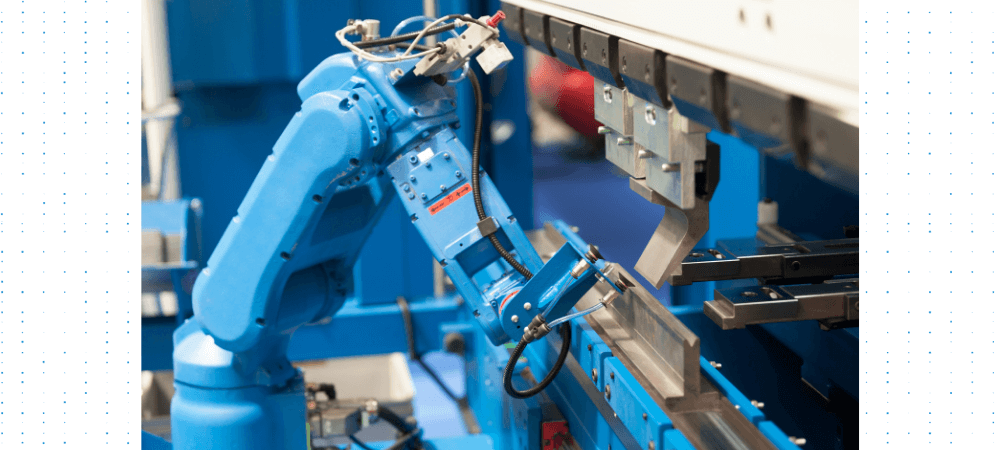
What is machine tending
Currently, most machine tending applications are done manually by human workers. However, since the tasks machine tending involves are often repetitive and it is becoming harder to find qualitative workers, production facilities can utilize robots to make up for the lack of employees and speed up the processes. But how does automated machine tending work and what are its applications? Before going into detail, let’s start with some simple definitions.
At its core, machine tending refers to loading and unloading a machine with parts or raw materials. Thus, in automated machine tending, robotic machine tending systems are used to tend a machine – typically a computer numerical control (CNC) machine.
How is robotic machine tending different from robotic material handling? A robotic machine tending system has to communicate with the CNC machine and it often performs multiple functions in a single application. Thus, it requires much more complexity than robotic material handling.
Benefits of machine tending
Robotic machine tending systems provide many benefits to manufacturers, including:
- High speed and increased production capacity: The use of robots for machine tending significantly reduces the loading and unloading time, decreasing part cycle time (the time needed to finish one piece). As a result, more parts can be produced than human operators would manage to. Moreover, robots can work 24 hours a day, 7 days a week in a row without human intervention needed for the feeding and unloading of materials. Thus, every second or minute saved can add up to a significant increase in productivity over time.
- Higher accuracy and increased product quality: Machine tending robots are able to complete even the most repetitive tasks an infinite number of times in exactly the same way. Therefore, they help eliminate human errors, increase the accuracy of the production process and thus improve the overall product quality.
- Reduced risk of injury: Manual machine tending often includes working in poor conditions such as exposure to harmful fumes, debris, or dust. Moreover, the highly repetitive and strenuous work of feeding a machine with materials or parts for extended periods of time increases the chance of workplace accidents. By using a robot instead of a human to carry out the tedious jobs machine tending involves, the risk of injury is significantly decreased.
- Lower operating cost: The initial investment in the implementation of machine tending automation represents a major capital investment, however, it will gradually provide significant returns that not only cover the initial cost of the robots, but also decrease operating costs.
- Small footprint: As space is already a precious commodity in many production facilities, machine tending robots are usually flexible and compact. Also, the robot can be strategically placed above or between two or more machines, which allows the robot to tend multiple machines at the same time.
Common applications of machine tending
Machine tending robots are typically used for loading and unloading parts or materials in the following applications:
- welding
- laser cutting
- grinding
- milling and turning
- compression molds
- injection molds
The processes machine tending robots perform may vary according to the application they are used in. The common function across all applications is, however, the loading and unloading of raw materials and parts.
Conclusion
In the increasingly globalized markets, competition in the production industry has never been more fierce. Factors such as product quality or production efficiency have become increasingly important by the day and therefore, manufacturing companies must leverage every advantage to remain competitive.
To address these challenges, more and more businesses across all industries are taking advantage of automated machine tending. Robotic machine tending systems offer many benefits to manufacturers – chief among them are accurate repeatability, increased production capacity, and reduced risk of injuries. Moreover, these systems are surprisingly affordable, as the higher initial investment will gradually translate into significant cost savings.
Photoneo vision systems and robotic intelligence software are highly flexible and universal systems, which makes them suitable for the automation of a wide range of industrial tasks, including machine tending.
For instance, Volkswagen Slovakia, a.s. uses the PhoXi 3D Scanner in an innovative application that enables the automation of one of its car body production processes. The PhoXi 3D Scanner identifies each part in a bin so that the robot can pick it, adjust its orientation using robotic intelligence SW from Photoneo, and insert it into a welding jig for further processing.
Another instance of a machine tending application utilizing the power of Photoneo technology is the bin picking of entangled metallic hooks for CapSen Robotics Inc.. The robotic task involves the picking of hooks from a cluttered pile one by one and inserting them into a press to get their ends formed. In the next step, the hooks are brought to another station where a bead is put on the flattened end of each hook. The hook and the bead then get pressed together with a spring that gets tapered around.
A different type of machine tending application is the picking of randomly positioned pipe parts from a container and placing them into a wedging machine. The solution was developed for Isotubi, S.L., where the task was performed manually before. A significant advantage of the solution is the possibility to handle different types of parts by switching the ID solutions of Bin Picking Studio. This provides great versatility and reduces the time required for changing the different pipe parts.
For more case studies, visit our section Projects & more.



